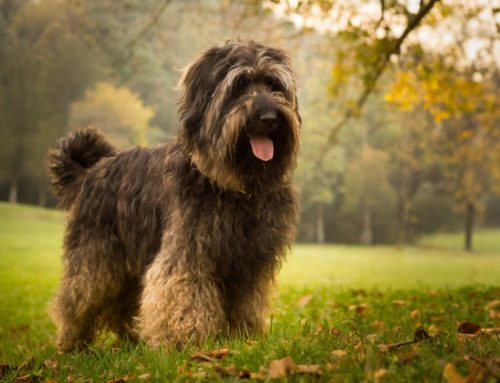
Bred in the Brie region, this long-haired sheepdog was historically used for herding sheep and as a guard dog. The Dutch Briard Club and the Briard Club of America are some of the associations dedicated to preserving this breed.
Originally, Briards were used as working dogs, including tracking wounded soldiers during war. These active dogs require plenty of exercise and mental stimulation.
FCI Group 1 Sheepdogs and Cattledogs
The Briard, a medium-sized French shepherd dog breed with a distinctive long, hard coat, belongs to the FCI Group 1: Shepherd Dogs and Cattle Dogs.
This group includes breeds that are naturally protective and often used for herding livestock. The Briard, also known as the Berger de Brie, is known for its intelligence, dedication and protective nature.
Coat of the briard and its appearance
A medium-sized dog breed known for its long, wavy coat, the Briard is a real eye-catcher. Typical for this breed is the colour fauve, but other shades such as black are also possible. The shoulder height of a Briard is usually around 55 cm, but can vary.
The Briard’s dense, double coat needs regular grooming to prevent tangles and keep the skin healthy. These dogs are naturally active and therefore require plenty of exercise and mental stimulation.
Hereditary diseases and disorders and health of the briard
The Briard, a breed with a long history as a herding dog, can be prone to various hereditary diseases and disorders.
It is important for breeders and owners to be aware of these health risks:
- Hip dysplasia: A common condition in larger breeds, in which the hip joints develop abnormally.
- Progressive Retinal Atrophy (PRA): An eye condition that can lead to blindness.
- Bloat or Stomach Torsion: A life-threatening condition in which the stomach twists and swells.
- Hypothyroidism: A hormonal condition that affects metabolism.
- Von Willebrand disease: A blood clotting disorder that can lead to excessive bleeding.
- Congenital Stationary Night Blindness (CSNB): A condition that affects night vision.
- Allergies: Briards can be prone to various allergies, ranging from food to environmental factors.
The character of this active dog
A medium-sized dog with a long coat, the Briard is a breed originally used for herding sheep and as a guard dog. Known for their intelligence and independence, these dogs need consistent training and plenty of exercise to expend their energy well.
They are naturally protective and can be reserved towards strangers, which makes them very suitable as a protective family dog. The Briard has a dense, hard outer coat and a softer undercoat that requires regular grooming to prevent tangles and matting.
They are devoted to their family and get along well with children and other pets, provided they are well socialised. Some Briards have an innate aptitude for tracking wounded soldiers, a task for which they were used during the First and Second World Wars.

Coat and dog care
Care of the Briard is intensive because of its long, hard outer coat and softer undercoat. It is important to brush the coat regularly to prevent tangles and keep it clean. This breed has specific grooming needs because of its history as a herding and guard dog. The Briard needs sufficient exercise, at least an hour a day, to stay healthy and happy.
The Briard’s health, including eye care and checking for hip dysplasia, is also essential. Attention to training and socialisation is necessary, given their intelligence and independent nature. Briards get along well with their families, including other pets, but should be well socialised with other dogs.
The breed is naturally protective and devoted to its family. Regular play and dog interaction promote good bonding and behaviour.
Socialisation and upbringing of this rescue dog
The socialisation and upbringing of a Briard are essential for its development. It is important to socialise them with people and other dogs from an early age so that they learn to deal with different situations and environments. The Briard is generally a dog that likes to be active and needs plenty of exercise to expend its energy.
Its coat should be brushed regularly to prevent tangles and keep it in good condition.
How much experience does keeping the Briard require
Owning a Briard can be challenging for both experienced and inexperienced dog owners. These dogs need consistent training. Experienced owners can better handle the Briard’s tendency towards independence, while inexperienced owners may need more support.
It is essential to pay attention to the Briard’s health, especially eye problems, and their long, hard topcoat requires regular grooming. These dogs need at least an hour of exercise daily.
They are highly intelligent and can be trained well, but also need social interaction and play. Rewarding good behaviour and providing a stable environment are important to prevent the Briard from becoming stubborn or protective. It is also recommended to give these dogs a bath once every eight weeks to keep the coat clean.
Is training necessary?
Training is indeed necessary for the Briard. These dogs are known for their intelligence and energy, but also for their independence and sometimes stubborn nature. Good training helps develop obedience and a strong bond between dog and owner. Early socialisation and consistent, positive training are essential to get a balanced and well-adjusted dog.
This is especially important as the Briard can be naturally protective, which can lead to problems without adequate training. Regular training also provides mental stimulation, which contributes to the dog’s overall satisfaction and well-being.
How much exercise does a Briard need?
A healthy Briard needs a considerable amount of exercise daily, given that it is an energetic and active breed. As a herding dog, the Briard naturally has a lot of stamina and is used to being active.
It is recommended that the Briard spend at least one to two hours a day in physical activity. This can include walks, playtime, and activities such as agility training or fetch. It is important to provide both physical and mental stimulation to prevent the dog from becoming bored and exhibiting unwanted behaviour.

How is it getting along with children?
The Briard is known for its friendly and protective nature, which generally makes it good with children. These dogs are loyal and affectionate, which makes them an excellent family companion dog.
However, they can also be protective, meaning they may be inclined to protect children in their family, especially if they think they are in danger. Because of their size and energy level, it is important that interactions between Briards and children are supervised, especially with smaller children.
Socialising the dog from an early age and teaching children how to treat dogs respectfully are essential to ensure a harmonious relationship.
Advantages of a Briard
- Loyal and Protective: The Briard is known for its deep loyalty to its family, making it an excellent watchdog.
- Intelligent and Trainable: This breed is intelligent and responds well to training, making it suitable for various activities and dog sports.
- Good with Children: They get along very well with children and are known for their patience and gentleness.
- Social with other Pets: With proper socialisation, they can live well with other pets.
- Active: Briards have a lot of energy and enjoy activities and long walks.
Disadvantages of a Briard
- Intensive Coat Care: Their long coat requires regular grooming to prevent tangles and dirt.
- Hip dysplasia and Eye problems: They can be prone to certain health problems such as hip dysplasia and eye problems.
- Size: Due to their size, they need adequate space and may not be suitable for very small living spaces.
- Strong Will: They can be stubborn, requiring consistent training.
- Socialisation Needed: Early and continuous socialisation is needed to prevent them from becoming reserved or overprotective.
How old a Briard gets
The life expectancy of a Briard typically ranges between 10 and 12 years. However, this lifespan can be affected by several factors, including genetics, lifestyle, and the quality of care the dog receives.
Price of a Briard
Anticipate spending between $1,500 and $3,000 for a Briard puppy sourced from a reputable breeder.
Determining Price Factors:
- Breeder’s Reputation: Higher prices are common for puppies from well-known breeders with a history of champion or working Briards.
- Pedigree: Registered Briards with the American Kennel Club (AKC) command higher prices than those without papers.
- Location Impact: Expect to pay more in regions with a higher living cost.
- Puppy vs. Adult: Puppies typically cost more than adult Briards.
- Coat Color Variations: Given the breed standard accepts fawn, black, or gray, color variations do not majorly impact price.
Breeds with Similar Traits:
For enthusiasts of the Briard’s distinctive traits, these breeds might also appeal:
- Beauceron: Shares the Briard’s French heritage, noted for its smarts, training capacity, and guardian nature, with prices around $1,500 to $3,000.
- German Shepherd Dog: Renowned for versatility, loyalty, and intelligence, with a price range of $800 to $2,500.
- Komondor: Distinguished by its unique coat and protective instincts, priced between $2,000 to $4,000.
Additional Considerations:
- Know the Breed: Briards are energetic and need active engagement. Their dense coats require consistent grooming.
- Breeder Visit: Assessing the health and temperament of the parents and puppies is crucial. Visit the breeder’s location for a firsthand look.
- Training & Socialization: Responsive to positive training, Briards thrive with early socialization and a variety of mental and physical exercises.
- Activity Requirements: Adequate daily exercise and mental stimulation are vital for their well-being.
Locating a Briard Breeder:
- Briard Club of America: A valuable resource for connecting with reputable breeders.
- Online Kennel Directories: Utilize these directories to find and contact Briard breeders in your vicinity.
Commitment to Responsible Ownership:
Embrace the lifelong commitment that comes with pet ownership. Consider adoption as a meaningful alternative, potentially connecting with Briards or similar breeds through shelters or rescue organizations at a lower cost.











